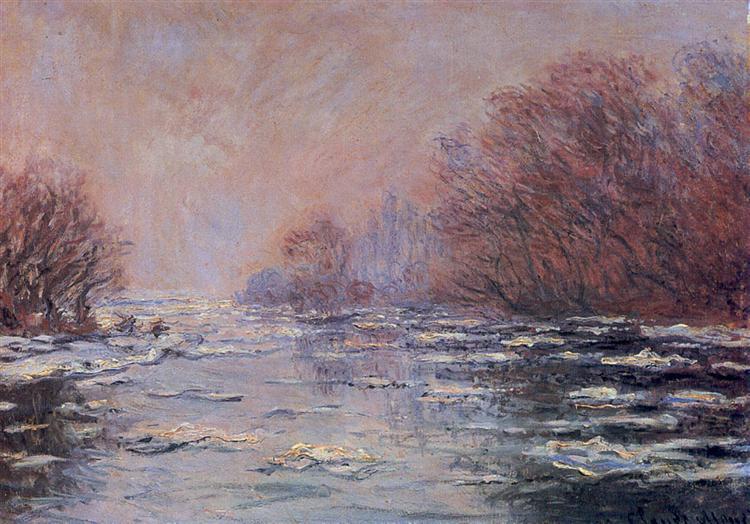Description
"River Thaw Near Vetheuil" is an iconic work by Claude Monet, painted in 1880, which encapsulates the essence of the Impressionist style and its author's mastery in capturing light and color in the landscape. Part of Monet's exploration of seasonal changes and their effect on the natural environment, this painting reveals not only his technical talent but also his deep connection with nature and contemplation of everyday life.
At first glance, the work appears as a transitional landscape, where the melting of the river suggests the return of life after winter. The composition focuses on the river's current, whose waters are reflected in a range of soft, greyish blues that contrast with the white of the ice at the edges. Monet distances himself from the detailed representation of the object, opting for a freer, looser treatment of the brushstroke, characteristic of Impressionism. When looking at this painting, one can feel the vibration of the air and the movement of the water, thanks to the artist's skill in capturing the diffuse light that filters through the clouds in a mostly grey sky, flecked with blue tones.
The colour palette employed by Monet is a noteworthy aspect. Cool tones such as blue, grey and white predominate, interspersed with warm hues that suggest the imminent arrival of spring. This colour choice not only emulates the cold atmosphere of thawing snow, but also speaks of the changing light of the day and the irresistible cycle of nature. As he approaches the shore, the quicker, looser brushstrokes create an almost abstract depiction that suggests riverside flora, adding a sense of movement and life to the scene.
As for the depiction of human beings, the absence of characters in the work can be interpreted as a deliberate choice on Monet’s part. The focus is entirely on nature, perhaps suggesting a search for introspection and connection with the environment beyond human interactions. This aligns with Monet’s focus on ephemeral moments and the transitory nature of the landscape. In this sense, the work invites the viewer to immerse themselves in the landscape, to feel the fresh air of the river and to appreciate the pure, raw beauty of nature.
This painting also sits within the broader context of Monet's work and the Impressionist movement. In the 1880s, Monet was actively exploring the depiction of light and atmospheric effects in his work, with an emphasis on capturing fleeting moments. Other contemporary works by Monet, such as The Almond Blossom or his landscape series, also explore the relationship between light, colour and form. Thaw River Near Vetheuil can be seen as a further manifestation of his tireless quest to find the essence of a moment in nature, a recurring theme in his work.
In conclusion, “River Thaw Near Vetheuil” is not only a reflection of nature and climate, but a profound meditation on the ephemeral beauty of natural phenomena. Monet achieves in this painting the duality between the faithful representation of a landscape and a freer and more emotional interpretation, as well as reaffirming his place as a pioneer of impressionism. The work invites a reflection on the temporality of life and the constant presence of nature around us, capturing a specific instant that resonates deeply with the viewer. The evocation of light, the softness of color, and the lack of human presence make this piece a masterpiece that persists in its relevance and beauty.
KUADROS ©, a famous painting on your wall.
Hand-made oil painting reproductions, with the quality of professional artists and the distinctive seal of KUADROS ©.
Painting reproduction service with satisfaction guarantee. If you are not completely satisfied with the replica of your painting, we will refund 100% of your money.

